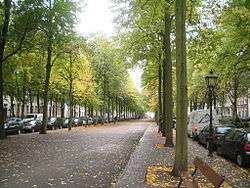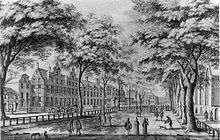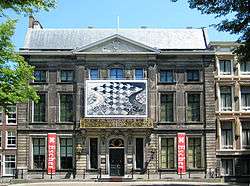Lange Voorhout
The Lange Voorhout (Dutch pronunciation: [ˈlɑŋə voːrˈɦʌut])[1] is a street in the old city centre of The Hague, Netherlands. It is L-shaped and runs from Kneuterdijk in the west to Toernooiveld in the east, reaching approximately 0.47 kilometres (0.29 mi) in length.
 Lange Voorhout in 2005 | |
| Length | 0.47 km (0.29 mi) |
|---|---|
| Location | The Hague, Netherlands |
| Coordinates | 52°4′56″N 4°18′41″E |
History

In the Middle Ages, the Lange Voorhout was bordered by several farms. Only in the 14th and 15th centuries, when the Counts of Holland modernised the governance of the county with new administrative divisions, were houses built in this area. The Lange Voorhout and surroundings pre-eminently became the neighbourhood where courtiers and later statesmen came to live. Between 1350 and 1450, the first town castles of nobles, houses of ducal staff, the Predikherenklooster and residences for high magistrates appeared here. But for centuries the elite did not hold the sole right to live on Lange Voorhout. For a long time, the street was a central terminus for all traffic from and to The Hague; wagons from Leiden and Scheveningen were garaged and unloaded here. This meant that inns, wheelwrights and forges were also established on the Lange Voorhout.
In 1536, Charles V, Holy Roman Emperor, visited The Hague. He decided that the front gardens of all the buildings should be joined together to create a broad avenue. He also ordered that four rows of lime trees be planted, giving it its stately aesthetic. In 1597, stadtholder Maurice, Prince of Orange, proposed to construct a canal along the street. After the Reformation, the Catholic minster was made into a cannon foundry, and a canal could have helped the transport of the heavy cannons. Although a canal was dug along the nearby Mauritskade, a connecting canal along the Lange Voorhout was never constructed, likely due to the high sand bank on which the street was located. In the Golden Age, the very rich settled in palace-like residences on the Lange Voorhout.[2][3][4]
Layout

Most Dutch renaissance buildings that were originally located along the Lange Voorhout were replaced in the 18th century. As a result, the houses along the Lange Voorhout today are predominantly 18th century, or constructed in the 19th or 20th century in an 18th-century style. Most of them are Rijksmonumenten. The street is home to a great many institutions and monuments. The Kloosterkerk, a 14th-century minster, is located at number 2. The Supreme Court of the Netherlands is in the building at number 34. Lange Voorhout Palace, today housing the Escher Museum, can be found at number 74. The learned society Diligentia, the art institution Pulchri Studio, as well as the embassies of the United Kingdom, Spain and Switzerland can be found on this street. A monument commemorating Prince Bernhard of Saxe-Weimar-Eisenach was constructed in 1864 near the southeastern end of the street. The former Michelin starred restaurants Saur and Royal were also located here.
References
- Lange Voorhout (in Dutch), VVV.NL. Retrieved 1 March 2016.
- "Lange Voorhout". Geschiedenis van Den Haag (in Dutch). Retrieved 26 June 2014.
- "Lange Voorhout (voir den Houte)". De Pagina's over Den Haag (in Dutch). Retrieved 26 June 2014.
- "Speech by Mayor Jozias van Aartsen at the opening of 'Grandeur', 17 June 2014". The Hague. 18 June 2014. Archived from the original on 26 October 2015. Retrieved 26 June 2014.
External links
| Wikimedia Commons has media related to Lange Voorhout, The Hague. |
- Uitburo (in Dutch)
- Den Haag Direct (in Dutch)